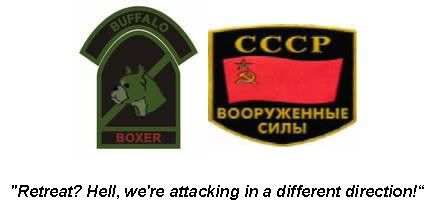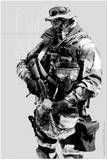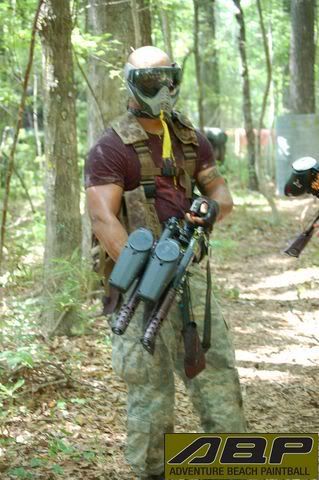Post by Xman on Nov 1, 2007 15:39:05 GMT -5
During the Ghost Buster’s scenario game one of our critical success factors was our ability to communicate effectively. This was a function of our equipment (upgraded UHF radios) and our exchange of information over our tactical net. But, being a former infantry battalion communications officer I think there are several things we can do that would really make our comms more efficient.
1. Talking Over Each Other – One of the things I noted was that there were several instances when more than one person would try to talk at once canceling each other out. I myself was guilty of this. One way to prevent this is to wait one second after a transmission has been completed by another station before speaking. This does two things.
First it lets the person talking complete their transmission before the next transmission begins.
Second, if there is a priority transmission it gives it a chance to get in. If you have priority traffic, as soon as you think the last transmission is complete break in with something like “break, break all stations Runaway has a priority message” this lets everyone know that Runaway has a critical message and that they should clear the net. If there are two priority messages at the same time the first one in takes precedence.
Runaway, keyed in on this during Ghostbusters, whenever he had a priority message he would say something like “ Command, permission to speak” after awhile I understood that when he said this he had a priority message and I had to clear the net to get his message. However, using a standard phrase like “break, break all stations Runaway has a priority message break” automatically lets everyone know what’s up.
2. Long Messages – This is definitely an area where I need to improve. Transmissions should be short and concise. If you are keying the mike for more than 3 or 4 second that’s too long. If you have a long message, break it into several smaller transmissions. You can separate them by the term Break. Break is a general term that lets other stations know that when you unkey the mike there is more to come so wait. For example, ““Enemy is approaching phase line eagle at objective H break,” pause 1 second then continue, “I count 10 tangos and 1 tank, over.” The term over means the other station can speak. Or you can say Out to indicate your transmission is over.
3. Station Identification – This wasn’t to bad but just as a reminder when you transmit make sure you say the call sign of who you are calling and then identify yourself. For example, “Runaway this is Xman over.”
Other things to consider are…
· Line of Sight – For any radio line of site comms is always going to improve transmission and reception quality. If you are experiencing broken or static heavy transmissions get to the highest ground near your position. Of course balance the tactical situation with your need to communicate when doing this. This will be important at Fulda, since the terrain is hilly and there are several spots where you will be in low ground surrounded by hills. We tested our comms ad Command Decisions and for the most part our radios could talk in most places but there are some low areas where comms will get tight, so just be aware.
· Listening To Radio Traffic – This is something that may seem obvious but very few people will do. If you have a free moment just listen to what’s happening on the radio. Many times this will give you information and Intel that is pertinent to your situation. You may hear something that causes you to reposition your squad or orient in another direction. You may hear something that ties in with a piece of information you have that will give us a better picture of the over all situation.
One thing we might consider is to have dedicated RTO’s whose job it is to manage the radio for the squad leaders. This becomes more critical when your running multiple radios, for example the Squad leader has a radio for his squad and one for command. The Squad leader will most likely use his squad radio more so he can monitor their activity while his RTO monitors the command channel. The RTO would not only receive and transmit messages from/to command they would monitor the channel for information that might be of interest to the squad leader.
For example, let’s say there are 2 squads operating near each other and one spots the opposition and radios that information back to command. The other squad would want to hear that because they might run into that same group. Information like the direction of travel, number, what they were doing are all things you might want to know so if you run into them you are prepared.
There are a whole host of other things we can do to make our use of the radios more effective.
· How to deal with a jammed or spoofed radio net. Jamming is when someone deliberately attempts to breaks your comms by keying over your net, preventing any stations from getting through. Spoofing is when the opposition gets on your net and tries to pass bogus information. There are procedures for dealing with both these situations.
· Authentication and Code Words – This is one way to defeat spoofing by forcing another station to validate themselves using some agreed upon code word or phrase. Code words hide the meaning of your transmission as long as only our side has the key to the code, At Fulda we will be using coded maps.
· Radio Silence - This is a tactic by which we would operate without radio transmissions in order to maintain the element of surprise. This only effective before springing the trap since once contact is made the enemy know you are there.
These technique are things we would do against more sophisticated opponents. Right now we are one of the few teams in are area (maybe the only one) that has a full suite of UHF radios. This gives us a few advantages.
1. No one else can talk on our channels which means we cant be jammed or spoofed.
2. We do not have to compete with other teams or the reffs using our channels. This was a big problem at Distant Thunder when both team ended up on the same radio channels.
3. The UHF radios have better range and clearer transmission. Do the squad leaders who went to Ghost Busters have any feedback?
Our advantage may last for awhile given the cost of the radios, but in time I’m sure more and more teams (especially the large sponsored ones) will migrate to these radios, at which point we may be forced to use some of the techniques above.
Tactical Radio Speak
The following is a summary radio terminology with their definitions and examples of how they are used.
Over – Communicates I have completed my message the next station can now transmit.
For example, “What are your orders, over?”
Roger – Communicates that you have received and understood the last
transmission.
For example;
Runaway transmits: “Xman this is Runaway, I am en route to
phase line Eagle.”
Xman responds: “Roger”
Xman doesn’t have to say anything else. Or he can add out to indicate
he has no more to say. “Roger, Out.”
Out – Communicates the transmission is over there is nothing else to follow.
Break- Indicates a pause but more to follow. For example:
“Enemy is approaching phase line eagle at objective H break,” pause 1 second then continue, “I count 10 tangos and 1 tank, over.”
Saying Break twice indicates your are going to break into someone
else transmission.
“break, break all stations Runaway has a priority message”
But again, great job this past weekend! Lets take Boxer to the MAX!
1. Talking Over Each Other – One of the things I noted was that there were several instances when more than one person would try to talk at once canceling each other out. I myself was guilty of this. One way to prevent this is to wait one second after a transmission has been completed by another station before speaking. This does two things.
First it lets the person talking complete their transmission before the next transmission begins.
Second, if there is a priority transmission it gives it a chance to get in. If you have priority traffic, as soon as you think the last transmission is complete break in with something like “break, break all stations Runaway has a priority message” this lets everyone know that Runaway has a critical message and that they should clear the net. If there are two priority messages at the same time the first one in takes precedence.
Runaway, keyed in on this during Ghostbusters, whenever he had a priority message he would say something like “ Command, permission to speak” after awhile I understood that when he said this he had a priority message and I had to clear the net to get his message. However, using a standard phrase like “break, break all stations Runaway has a priority message break” automatically lets everyone know what’s up.
2. Long Messages – This is definitely an area where I need to improve. Transmissions should be short and concise. If you are keying the mike for more than 3 or 4 second that’s too long. If you have a long message, break it into several smaller transmissions. You can separate them by the term Break. Break is a general term that lets other stations know that when you unkey the mike there is more to come so wait. For example, ““Enemy is approaching phase line eagle at objective H break,” pause 1 second then continue, “I count 10 tangos and 1 tank, over.” The term over means the other station can speak. Or you can say Out to indicate your transmission is over.
3. Station Identification – This wasn’t to bad but just as a reminder when you transmit make sure you say the call sign of who you are calling and then identify yourself. For example, “Runaway this is Xman over.”
Other things to consider are…
· Line of Sight – For any radio line of site comms is always going to improve transmission and reception quality. If you are experiencing broken or static heavy transmissions get to the highest ground near your position. Of course balance the tactical situation with your need to communicate when doing this. This will be important at Fulda, since the terrain is hilly and there are several spots where you will be in low ground surrounded by hills. We tested our comms ad Command Decisions and for the most part our radios could talk in most places but there are some low areas where comms will get tight, so just be aware.
· Listening To Radio Traffic – This is something that may seem obvious but very few people will do. If you have a free moment just listen to what’s happening on the radio. Many times this will give you information and Intel that is pertinent to your situation. You may hear something that causes you to reposition your squad or orient in another direction. You may hear something that ties in with a piece of information you have that will give us a better picture of the over all situation.
One thing we might consider is to have dedicated RTO’s whose job it is to manage the radio for the squad leaders. This becomes more critical when your running multiple radios, for example the Squad leader has a radio for his squad and one for command. The Squad leader will most likely use his squad radio more so he can monitor their activity while his RTO monitors the command channel. The RTO would not only receive and transmit messages from/to command they would monitor the channel for information that might be of interest to the squad leader.
For example, let’s say there are 2 squads operating near each other and one spots the opposition and radios that information back to command. The other squad would want to hear that because they might run into that same group. Information like the direction of travel, number, what they were doing are all things you might want to know so if you run into them you are prepared.
There are a whole host of other things we can do to make our use of the radios more effective.
· How to deal with a jammed or spoofed radio net. Jamming is when someone deliberately attempts to breaks your comms by keying over your net, preventing any stations from getting through. Spoofing is when the opposition gets on your net and tries to pass bogus information. There are procedures for dealing with both these situations.
· Authentication and Code Words – This is one way to defeat spoofing by forcing another station to validate themselves using some agreed upon code word or phrase. Code words hide the meaning of your transmission as long as only our side has the key to the code, At Fulda we will be using coded maps.
· Radio Silence - This is a tactic by which we would operate without radio transmissions in order to maintain the element of surprise. This only effective before springing the trap since once contact is made the enemy know you are there.
These technique are things we would do against more sophisticated opponents. Right now we are one of the few teams in are area (maybe the only one) that has a full suite of UHF radios. This gives us a few advantages.
1. No one else can talk on our channels which means we cant be jammed or spoofed.
2. We do not have to compete with other teams or the reffs using our channels. This was a big problem at Distant Thunder when both team ended up on the same radio channels.
3. The UHF radios have better range and clearer transmission. Do the squad leaders who went to Ghost Busters have any feedback?
Our advantage may last for awhile given the cost of the radios, but in time I’m sure more and more teams (especially the large sponsored ones) will migrate to these radios, at which point we may be forced to use some of the techniques above.
Tactical Radio Speak
The following is a summary radio terminology with their definitions and examples of how they are used.
Over – Communicates I have completed my message the next station can now transmit.
For example, “What are your orders, over?”
Roger – Communicates that you have received and understood the last
transmission.
For example;
Runaway transmits: “Xman this is Runaway, I am en route to
phase line Eagle.”
Xman responds: “Roger”
Xman doesn’t have to say anything else. Or he can add out to indicate
he has no more to say. “Roger, Out.”
Out – Communicates the transmission is over there is nothing else to follow.
Break- Indicates a pause but more to follow. For example:
“Enemy is approaching phase line eagle at objective H break,” pause 1 second then continue, “I count 10 tangos and 1 tank, over.”
Saying Break twice indicates your are going to break into someone
else transmission.
“break, break all stations Runaway has a priority message”
But again, great job this past weekend! Lets take Boxer to the MAX!






